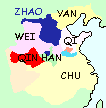
Warring
States
(475 - 221 BC.)
![]()
Previous Dynasty
 |
Warring
States |
Previous Dynasty |
 |
This is the
height of the feudal period of what is next to become a unified
"China". Although incessant wars between the 7 major states
(see large map) never offered peace, this period is still characterized by
rapid economical and cultural expansion. This is also the
final death rattle of the once so mighty Zhou.
The period starts with usurpation of government power in the state of QI and the division of the JIN state into ZHAO, WEI and HAN. It all ends 255 years later when the Western state of QIN annexes the other 6 major states in 221 BC. |
|
|
7 Major States |
The great Zhou state is drawing to its inevitable end. With no more land for granting new fiefdoms Zhou loses its ability to suppress potential rivals. Zhou's vassal states, the hundreds of small semi-independent city-states inhabited by warrior nobles, have now created their own new territorial entities with fixed boundaries and defense walls. The King of Zhou stands powerless by while the more powerful of these new states conquer the weaker ones. The Zhou state is reduced to a small area around its capital of Luoyang. In 483 BC Zhou's weakness is exposed when the Tian family in a coup d'etat deposes the Jiang family, loyal vassals of Zhou, from its rule of the rich Qi state in the east. The King of Zhou stands helpless. Three other aristocratic families seize the opportunity to divide the large Jin state into three, marking the beginning of the period known as the "Warring States". In the next quarter of a millennium the seven most powerful states of Qi, Qin, Chu, Yan, Han, Zhao and Wei (see map) fiercely battle each other for territorial gain. These great states of the later Eastern Zhou period are purely designed for military expansion and ever more bloody and destructive warfare ensues. Reflecting the troubled times philosophy flourishes. Confucius' thoughts for statesmen are refined and written down and Daoism emerges as an escape valve for the masses. But it is the Legalists' harsh view of human beings that ultimately unites China. The Warring States Period is frequently also referred to as "A Hundred Schools of Thought". The writing on the wall is clear to all the big states: The blood letting will only stop if one state conquers all the other ones or if a completely new type of state emerges. It was to be the former of these two outcomes. Starting his quest in 230 BC, King Zheng of Qin, originally one of the weakest and most backward of the seven states, in only 9 years triumphs on the battlefield (see "The Final Campaigns") and becomes ruler of them all. In 221 BC ends not only the "Warring States" period but also the Zhou rule that began almost 900 years earlier, around year 1100 BC. The Qin Dynasty emerges... |
Special Features:
More to come... |
||||||||||||||||